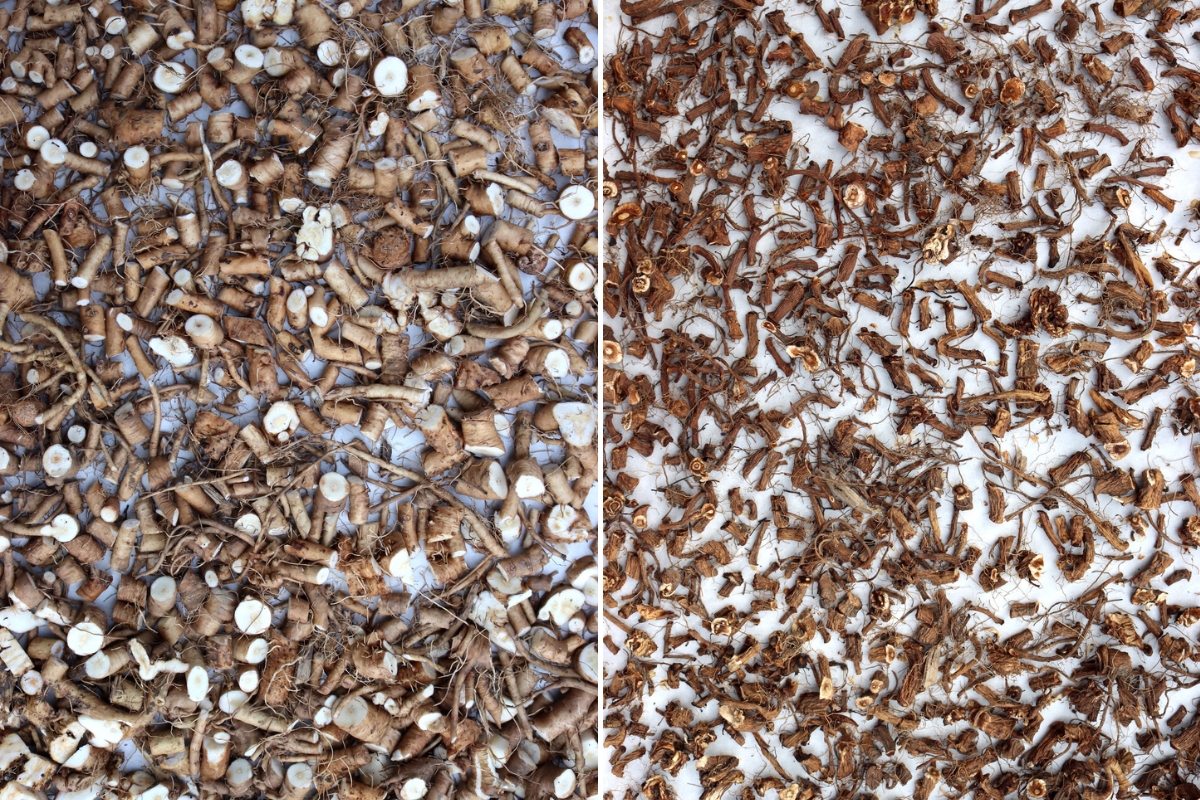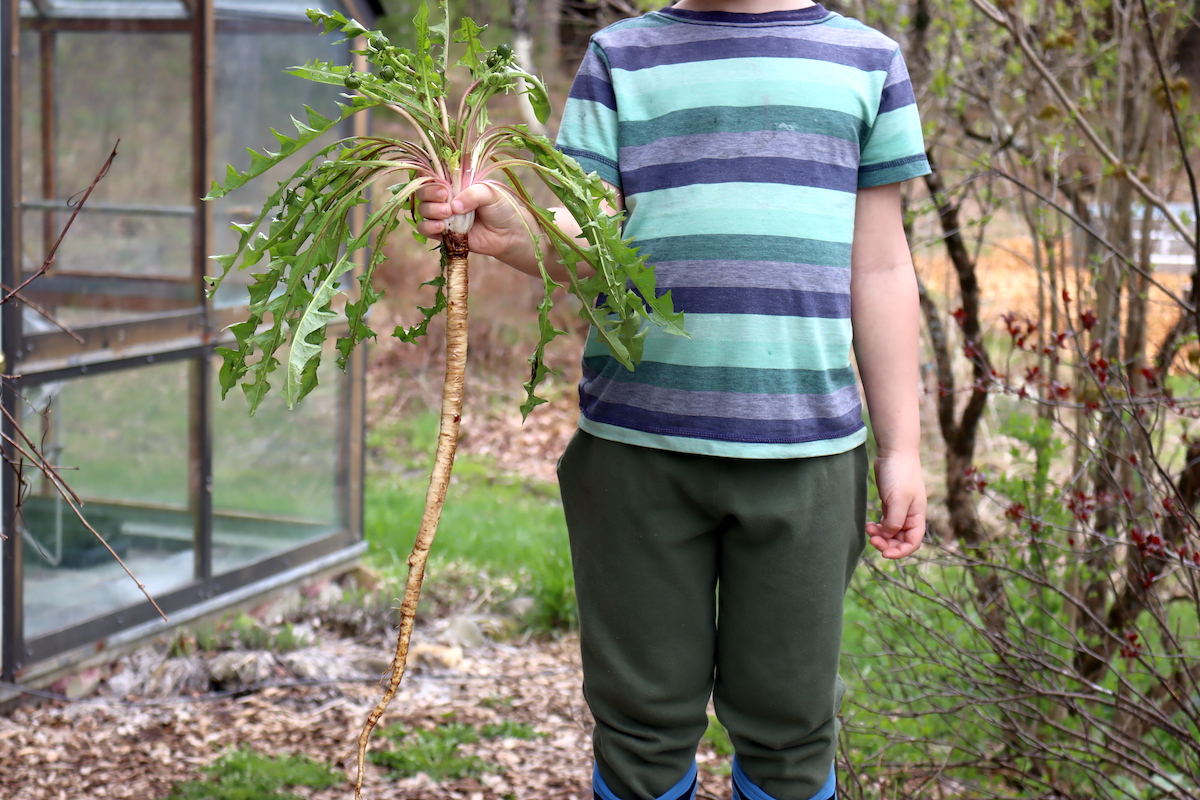Affiliate disclosure: This post may contain affiliate links. Please see our Privacy Policy.
Dandelion roots are an often overlooked part of the dandelion, but it’s where most of the health benefits (and nutrition) reside. Learn new ways to cook dandelion roots, both savory and sweet, and you’ll turn weeding into harvesting.

Table of Contents
- Harvesting Dandelion Roots
- Dandelion Root Recipes
- Dandelion Root Fries
- Dandelion Root Carrot Cake
- Roasted Dandelion Root Coffee
- Dandelion Root Ice Tea
- Dandelion Root Kombucha
- Dandelion Root Milkshake
- Roasted Dandelion Root Ice Cream
- Roasted Dandelion Root Muffins
- Dandelion Root Donuts
- Dandelion Herbal Bitters
- Dandelion Tincture
- Dandelion Root Infused Honey, Vinegar, and Oxymel
- Dandelion Recipes
- Foraging Wild Roots
While dandelions are free to take over our lawns and fields as a food source for the bees, I draw the line at my garden beds. While they are edible root to blossom, they’re also incredibly prolific, and they’ll quickly take over a strawberry bed in the blink of an eye.
Dandelions will come back over and over again if you don’t get the root, and those big tap roots are tricky to pull without stout muscles. If you’re going to go through all that effort to get them out, you might as well turn your weeding into harvesting.
That’s right; dandelion roots are edible!
(This post is part of a series on eating every part of the dandelion. Here’s where you can find a full list of dandelion recipes, as well as specific dandelion flower recipes. Dandelion greens recipes are coming soon!)

Harvesting Dandelion Roots
Dandelions form tap roots, much like carrots. In really soft sandy soil, they’ll produce roots up to 2 feet long.
For the most part, they’ll grow straight and long, in those ideal conditions. These “pampered” dandelion roots are easy to work with and easy to peel.

For the most part, dandelions don’t grow in “pampered” places and sprout through sidewalk cracks and abandoned lots. Our soil isn’t the best in many places, and we are blessed with classic new england soil.
(There’s a reason they built all those rock walls all those years ago…)
Generally, dandelion roots will be a bit twisted and split, and it can be tricky to get them clean. Wash them thoroughly outdoors with the hose, but then bring them inside for a good soak and scrub in the kitchen sink.

Once washed, you can use your dandelion root fresh in place of carrots in many different recipes. It’s best if you peel the roots, and soaking them in water can help remove any residual bitterness.
Most of the “bitter” dandelion flavor is in the peel, so peeling is often enough to make them quite mild and sweet.

Be aware that dandelion roots oxidize to a brown color if peeled and left in the air, so you’ll want to submerge them in water to prevent browning.
I used peeled and grated dandelion root to make a dandelion root cake (like a carrot cake), which was absolutely delicious. I soaked the grated dandelion root in water for a few hours, mostly because I didn’t have time to make the cake right away, and I think it helped give the cake a mild flavor.

Many dandelion root recipes call for chopping and roasting the roots.
In that case, you’ll want to wash them thoroughly, and then chop them into 1/2-inch pieces. Roast the roots at about 350 for roughly 40 minutes, until they’re browned, crisp, and dry.

This process enhances their flavor (for things like dandelion coffee), but it also dries and helps preserve them at the same time.
If you get the roots thoroughly dried and toasted, you can store them, like any dehydrated food, in a jar right on the pantry shelf.
(If you purchase already cleaned and dried dandelion root, you can toast it by putting it in a 350-degree oven for about 15 minutes until it browns.)

Dandelion Root Recipes
Whether roasted or fresh, these dandelion root recipes will help you get the most out of your dandelion harvest.
Simple Cooked Dandelion Roots
One of the simplest dandelion root recipes is boiled dandelion roots, which are more or less made like boiled carrots.
In this case, since you’re going to be cooking them whole, peeling isn’t necessary. When dandelion roots are boiled, the skin slips right off the central core. That’s especially convenient for dandelion roots that aren’t straight or have lots of nobbly bits which would be hard to peel with a knife.
Once you’ve boiled and peeled them, toss them with a bit of butter and salt and enjoy. (You can also mash them like potatoes or parsnips for a dandelion root puree that’s quite tasty too.)

Dandelion Root Fries
If you’re craving a salty treat, try your hand at making Roasted Dandelion Root Fries.
For this recipe from Herbal Revolution just has you cut the roots lengthwise, toss them in olive oil and then roast them at 350 for about 15 minutes.
Keep in mind that with the peels on they’ll be a bit bitter, but roasting them helps cut the bitterness, and they’re still really tasty fries.
Add in a good dipping sauce, and they’re perfect!
Dandelion Root Carrot Cake
Since dandelion roots are very much like carrots, albeit with a slightly different flavor, I decided to make a “dandelion root cake” by substituting grated dandelion roots in place of carrots in my favorite carrot cake recipe.
In the end, the dandelion root cake came out more like a moist spice cake because the dandelion roots actually give it a lot less flavor than carrots would. You really can hardly notice they’re there, at least in terms of flavor, but it gives the cake an amazing texture and soft crumb.
I peeled the dandelion roots, and then grated them and soaked them in water for a few hours before incorporating them into the batter. I wasn’t trying to leach them, I just didn’t have time to bake the cake right away after I processed them, but it worked out really well.
The cake was super mild, and I decorated it with a few dandelion petals. (I regretted that though, as the dandelion petals were kind of stringy, and the least tasty part of the cake. I’ll skip those in the future, as the dandelion root cake itself was delicious.)

Roasted Dandelion Root Coffee
Probably the most classic dandelion root recipe, most people turn their dandelion roots into a simple coffee substitute.
My daughter loves to have “coffee” dates with me, and I make her up a cup of dandelion root coffee so she can sip a caffeine-free drink next to me on the porch on sunny spring mornings.
(In the autumn, we make acorn coffee for her, so there are plenty of wild foraged coffee substitutes depending on the season.)

Dandelion Root Ice Tea
Very similar to dandelion root coffee, you can brew it a bit milder and then serve it over ice for Dandelion root ice tea.
It tastes quite a bit like southern sweet tea if you add enough sugar, but I’m partial to a little homemade maple syrup to sweeten it up.
Dandelion Root Kombucha
Once you have tea (or coffee), you can turn it into Dandelion root kombucha with a bit of sweetener and a kombucha mother.
It more or less makes a fizzy probiotic soda, but without the caffeine that usually comes with kombucha.

Dandelion Root Milkshake
Since roasted dandelion roots have a “coffee” like flavor, the next rational thing to do is to mix them with chocolate, since coffee and chocolate flavors pair so well.
A Chocolate Dandelion Root Milkshake takes dandelion root coffee to the next level!
Roasted Dandelion Root Ice Cream
If you can make coffee, and turn it into a milkshake, you can skip the middle man and just make roasted dandelion root ice cream. I have a recipe posted for acorn ice cream which uses roasted and ground acorn coffee as a flavoring for ice cream, and you can replace the acorn coffee with roasted and ground dandelion root.
Roasted Dandelion Root Muffins
Usually, roasted dandelion roots are turned into a coffee or tea-like beverage, but you can also use those same root teas to flavor baked goods.
My friend Colleen did that when she made these Roasted Dandelion Root Muffins (Paleo and Gluten Free).

Dandelion Root Donuts
If you can use the tea to flavor muffins, of course you can also use it to flavor Dandelion root tea donuts!
Dandelion Herbal Bitters
Rather than infusing dandelion roots into water for coffee or tea, you can also infuse them into alcohol to make homemade bitters. This recipe for Dandelion and Burdock Herbal Bitters uses both dandelion and burdock roots, which are classic ingredients for commercial bitters.
While fancy herbal bitters are expensive to buy, they’re easy and cheap to make, and they really do make a spectacular cocktail.

Dandelion Tincture
Very much like herbal bitters, a herbal tincture is just an alcohol extract that’s used for medicinal purposes. That’s right; dandelions have medical benefits!
Usually, dandelion tincture is made out of dandelion roots, and I do it that way most years. Occasionally I’ll make a batch of “whole plant” dandelion tincture using the leaves and flowers as well.
Most of the medicinal properties are in the roots, so you can skip the other parts, or add them for a well-rounded extract.

Dandelion Root Infused Honey, Vinegar, and Oxymel
A dandelion tincture isn’t the only way to infuse dandelion roots for medicinal use. Herbal-infused honey, Herbal-infused vinegar, and herbal oxymels also work well with dandelion root.
I hope to make a dandelion oxymel this year, combining honey, apple cider vinegar, and dandelion roots in equal proportions. After steeping for about six weeks, the dandelion roots are filtered out, and then you can use the oxymel.
The vinegar and honey are preservatives, so they keep a long time on the shelf.
You can skip the vinegar and make a sweet Dandelion root-infused honey.
Dandelion Recipes
Looking for more dandelion recipes?
Foraging Wild Roots
Looking for more wild edible roots to incorporate into your cooking?





Wow! I’ve made sauteed buds, roasted the roots (just to chew on for health’s sake), salad, tea… but never imagined things like cake, fries, milkshakes… Love it!